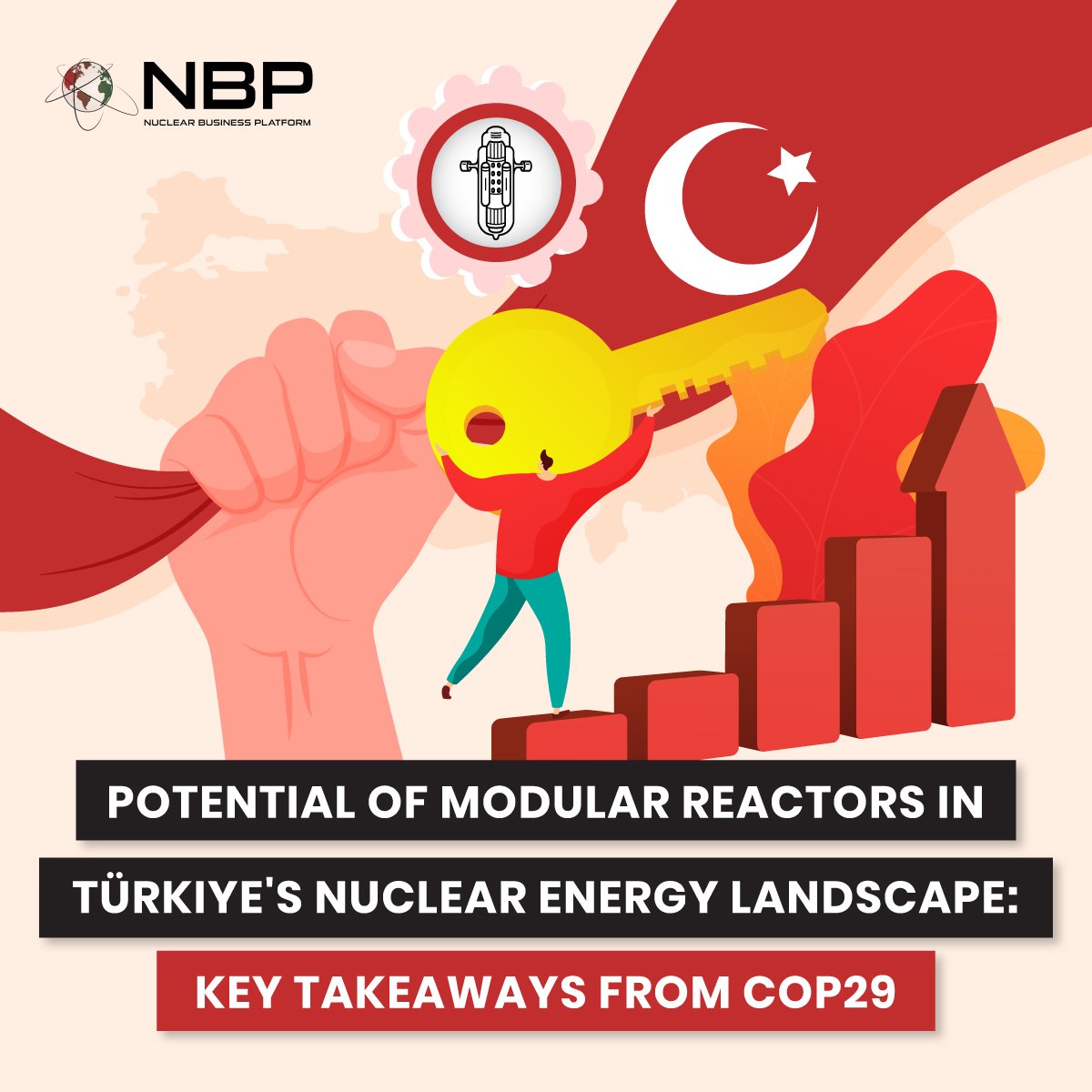Potential of Modular Reactors in Türkiye's Nuclear Energy Landscape: Key Takeaways from COP29
The 29th United Nations Climate Change Conference (COP29), held in Baku, Azerbaijan, brought nuclear energy to the forefront of global decarbonization discussions, underscoring the importance of innovative solutions like Small Modular Reactors (SMRs). Türkiye, a key participant, has emerged as a significant advocate for nuclear energy, reflecting its strategic ambitions through its recent inclusion in the "Declaration to Triple Nuclear Energy by 2050." As Türkiye charts its nuclear future, SMRs are increasingly recognized as a vital component in achieving its energy and sustainability goals.
Türkiye’s Nuclear Energy Vision
Türkiye’s National Energy Plan (2020–2035) positions nuclear energy as a central pillar of its energy strategy, with an ambitious goal of increasing total electricity generation capacity to 189.7 GW by 2035. Nuclear power is set to contribute significantly to this target, with plans to achieve 7.2 GW of nuclear capacity by 2035 and a long-term objective of reaching 20 GW by 2050.
At the core of this vision lies the Akkuyu Nuclear Power Plant, Türkiye’s first nuclear facility, with a capacity of 4.8 GW. Plans for the Sinop Nuclear Power Plant and the Thrace Nuclear Power Plant aim to add 4.8 GW and 5.6 GW, respectively, further solidifying Türkiye's commitment to large-scale nuclear infrastructure. However, beyond these conventional reactors, Türkiye is also focusing on SMRs to diversify and strengthen its energy portfolio. By 2050, the nation aims to achieve 5 GW of SMR capacity, reflecting its strategic adoption of cutting-edge nuclear technologies.
Insights on SMRs from COP29
Discussions at COP29 illuminated the transformative potential of SMRs in addressing diverse energy needs. A joint event by the International Atomic Energy Agency (IAEA) and the United States highlighted SMRs as versatile solutions capable of powering remote communities, data centers, energy-intensive industries, and even commercial shipping. The IAEA projected that SMRs could comprise a quarter of new nuclear capacity by 2050, provided global nuclear capacity expands 2.5 times.
Reaffirming Türkiye’s nuclear ambitions, Abdullah Buğrahan Karaveli, Chairman of the Executive Board and President of the Turkish Energy, Nuclear and Mineral Research Agency (TENMAK), expressed the nation’s dedication to advancing SMR technology alongside traditional large-scale reactors. His remarks underscored Türkiye’s dual approach to integrating innovative and established nuclear solutions into its energy strategy.
International collaborations are pivotal in Türkiye’s SMR plans. Companies such as Westinghouse Electric Co. are actively engaged in discussions to support Türkiye’s SMR initiatives. Additionally, Rolls-Royce has signed a Memorandum of Understanding (MoU) to explore deploying its 400–450 MWe SMR technology in Türkiye. With the SMR market in Türkiye projected to grow to between $10–30 billion by 2050, these partnerships represent significant opportunities for advancing nuclear technology and fostering economic growth in the country.
Addressing Challenges in SMR Adoption and Development
Despite the promise of SMRs, their widespread adoption faces notable challenges. High initial costs remain a significant barrier, requiring substantial upfront investments that can deter stakeholders. To address this, public-private partnerships are essential to distribute financial risks and attract private investors. Regulatory complexities further complicate SMR development, as diverse standards and approval processes across different jurisdictions often delay project timelines. Addressing this issue, Ibrahim Halil Dere, Vice President of the Turkish Nuclear Regulatory Authority (NDK), remarked at the Türkiye Nuclear Business Platform (TNBP) 2023: “NDK is poised to navigate and overcome regulatory challenges by dedicating the necessary resources and efforts to understanding and regulating these varied reactor technologies, including the intricate domain of SMR.”
Supply chain constraints also pose a challenge, particularly in establishing reliable sources for the specialized components required for SMR construction. International collaboration and investments in local manufacturing can mitigate these issues. Additionally, workforce development is critical to ensuring a skilled labor pool is available to support SMR technology. Without targeted training initiatives, the expertise needed to operate and maintain these reactors could lag behind the pace of development.
Finally, the IAEA has emphasized the importance of streamlining the numerous existing SMR designs to reduce manufacturing costs. Moving from first-of-a-kind to nth-of-a-kind reactors requires a unified approach to design standardization and mass production. This, combined with government-backed guarantees and innovative financing mechanisms, can significantly enhance the commercial viability of SMRs.
A Strategic Path Forward
Türkiye’s commitment to integrating Small Modular Reactors (SMRs) into its energy landscape reflects its pragmatic and forward-looking approach to nuclear energy. With a target of achieving 5 GW of SMR capacity by 2050, the country aims to address diverse energy demands spanning industrial hubs, remote communities, and growing economic sectors.
Collaborative efforts with international partners emphasize the potential of Türkiye’s SMR market as a driver of innovation and economic progress. Platforms such as the Türkiye Nuclear Business Platform (TNBP) play a critical role in these endeavors by bringing together global nuclear stakeholders, government bodies, financial institutions, and technology developers. These engagements facilitate knowledge sharing, policy alignment, and investment opportunities crucial for advancing SMR adoption.
The discussions at COP29 reaffirmed the pivotal role of SMRs in the global energy transition. For Türkiye, this presents an opportunity to lead by example, showcasing how a nation can harmonize advanced technologies with strategic energy goals.



